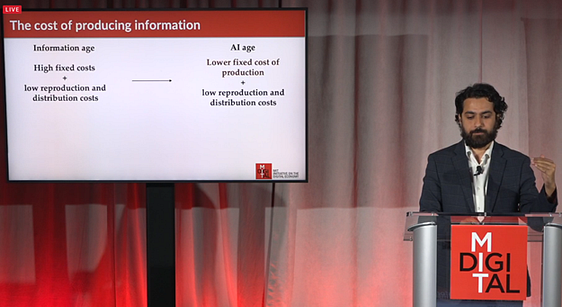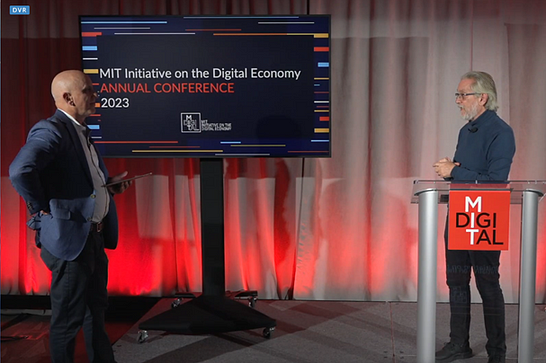
MIT reserachers see blockchain-based decentralized frameworks as the next generation of the Internet; the economic disruption could be huge.
By Paula Klein
The next wave of the Web is rolling in and it’s massive.
Avatars simulating daily transactions in the metaverse may still be more typical in games than in real life right now, but a nascent Web3 for the distribution of goods and secure financial exchange is taking shape — and its potential for disruption is already being considered.
Next-generation internet technologies were described at the MIT IDE Annual Conference May 18 by researchers working in the newly formed IDE Web3 research group. Led by MIT Professor and IDE Director Sinan Aral, this group’s focus is decentralized technology architectures — most based on blockchain — that serve as the framework for economic models, currencies, and social interactions that break with the past.
Aral said that the group’s research won’t be led by hype but “will focus on how Web3 can make meaningful, long-term changes to the current internet that will impact finance, technology, and business strategies.”

The Internet as we know it isn’t being replaced anytime soon, but the pace of Web3 development is clearly accelerating, Aral said. IDE researchers are studying whether decades of established economic rules that shaped first and second-generation Internet models are still valid, and also how decentralized ecosystems can be more efficient and secure. Moreover, what will be the results of these highly disruptive changes? [Read more on Aral’s ideas on Web3 here.]
Postdoctoral Associate Harang Ju offered some Web3 basics during the conference. Fundamentally, he said, “decentralization is a key feature of blockchain networks allowing for distributed trust, open protocols, and consensus among participants.” However, he added, “decentralization can vary significantly across different blockchain networks,” and more investigation is necessary. [Read more about Web3 fundamentals here.]

Specifically, the biggest difference between Web3 and previous generations of the web is that users can own the rights to content in addition to reading it and writing it.
Moreover, they can own digital assets and currency “natively” on the Internet without intermediaries. For instance, Ju said, payments and currencies can be exchanged or traded without central banks or services like Venmo. Instead, blockchain technologies and ledgers keep track of transactions providing individual access and security. Ultimately, this will lead to a decentralized finance (DeFi) that includes tokenization, such as non-fungible tokens (NFTs).
Ju and other IDE researchers maintain that today’s centralized networks are actually less secure and more vulnerable to hacks than Web3 designs that have no single point of failure.

Certainly, in these early years there are many caveats to watch and examine. Among Ju’s projects is creation of a real-time dashboard to monitor the state of Web3 fluctuations such as market swings, ownership changes, and blockchain design.
Another IDE Postdoctoral Researcher, Madhav Kumar, also emphasized how dramatically the digital economy has transformed in the last decade and how digital ownership is evolving. Kumar noted that as we transition from Web2 to Web3, we need to revisit long-held economic principles and assumptions, too.
For example, the seminal Information Rules strategies written by Carl Shapiro and Hal Varian in 1999, may not apply to a world of DeFi, NFTs, and blockchain-based marketplaces. When the book was written, researchers expected Information Age technologies to change, but not underlying economic laws.

Kumar said that in today’s AI Age a combination of forces is at work that may change former beliefs. First, lower production costs also lower our ability to produce and create goods. Additionally, interoperability will replace “long-term lock-in and high switching costs” creating more open networks for more users. Simultaneously, GPT AI and large language models (LLMs) will accelerate the transition to new networks, he said.
When will this all happen? Aral said that “we’re at the cusp of Web3 right now,” and some of these ideas are still aspirational.
“I’d like the Web3 to be open-sourced, shared, and equitable, but we could also be at a tipping point of a giant winner-takes-all market. The Web3 promise of decentralization is not here yet.”
NFTs and tokenization are unfamiliar concepts and have little in common with predigital or even current paradigms for digital goods. Questions abound: How much are tokens worth? Who decides their value, and how are they used?
Reserach is under way to address these concerns. MIT Postdoctoral Associate Ehsan Valavi described his work on Scarcity and Valuation in Web3 economic systems drilling down into NFT characteristics and their impact on pricing dynamics. [More background can be found here.]

While we’ve heard of digital artwork and collectibles bought and sold with NFTs, NFTs may also be used to tokenize assets such as documents, deeds, concert tickets, books and everyday items, Valavi said. Figuring out the supply and demand for these items will help understand retail pricing models for the future, he said.
Once you grasp the basics of Web3 and decentralization, you can imagine how it might scale to even higher levels. Alex ‘Sandy’ Pentland, Research Group Lead, MIT IDE, and a thought leader on data-driven societies, told IDE Annual Conference attendees about his latest work on Building a Distributed Economy.
Pentland envisions a distributed world where finance, manufacturing, data, and human resources are decentralized, causing profound transformation of the traditional roles of corporations and employees, sometimes known as Distributed Autonomous Organizations (DAOs). “Building a distributed economy is one of the most critical problems we’re facing,” he said. To find solutions, we need different approaches and innovative thinking about the current Internet.
Echoing other IDE researchers at the conference, Pentland said that blockchain-based organizational models can counter the rise of cyberattacks. “Today’s digital systems — social, financial, trade — are prone to fraud, violation of data ownership rights, and are inefficient,” he said. Tokenization, auditable distributed ledgers, and AI are part of solution because “there’s no single honeypot that can be hacked.”

IDE Executive Director, David Verrill (right) with Sandy Pentland
Pentland advises and helps build huge decentralized frameworks for businesses, governments (such as Singapore and Australia), and global organizations. His group is focused on software, regulations, policy, and legal infrastructures that support distributed organizations. The goal is to spur innovation and improve transactions without infringing on individual data privacy. China is far along on blockchain networks, Pentland said, and “we’re beginning to see a tidal wave” of support for these ideas. At the same time, “we’re still learning a lot along the way.”
